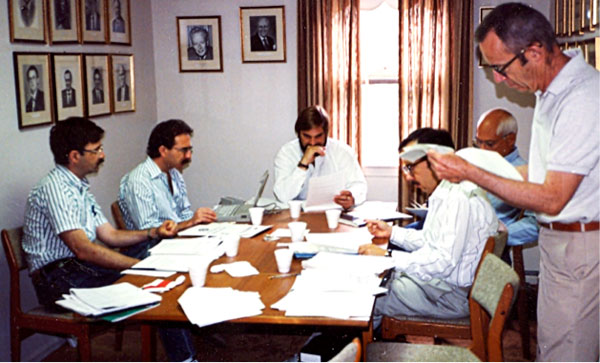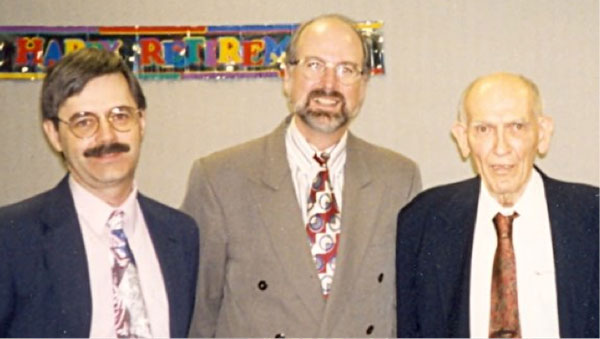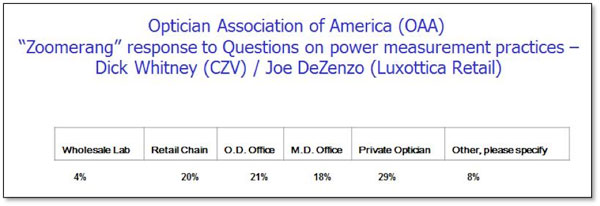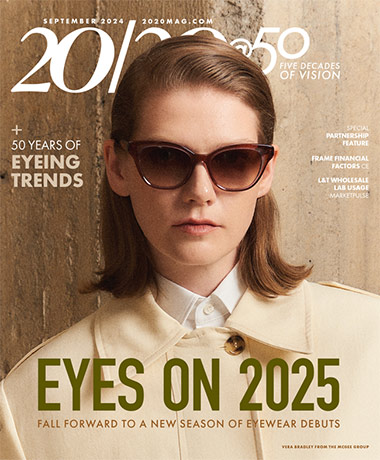
|
This simple statement is intended to convey that the end user receives quality eyewear (when ANSI Standards are followed). I suspect many readers have frequently used such a sentence when discussing inspection procedures. Is your knowledge of ANSI Z80.1 current? Do you really know what it means to follow ANSI Standards? Don't worry, you are not alone if you answer 'No' to the questions above.
I chair the ANSI Z80.1 committee; having taken over from Dan Torgersen after the most recent 2010 revision was released. I have been an active member on this committee since 1990; one of my first contacts was Mark Mattison-Shupnick, and I am pleased to be back collaborating with him today by submitting articles to the Opticians Handbook. When I first began my Standards work our respective companies, in my case American Optical and Mark's SOLA Optical, to participate on this industry committee. Both of our companies were subsequently bought by Zeiss and formed Carl Zeiss Vision, my employer today. As ANSI Z80 committee members, Mark and I also were sent as US delegates to ISO Standards meetings by ANSI. Serving on ISO committees is a function that I continue to do today through the U.S. standards body, in our case ANSI.
 |
|
Dick Whitney (l) with Mark Mattison-Shupnick sitting next to him at OMA (now Vision Council) headquarters in 1990. |
ANSI Z80.1 Standards—Organizational Makeup and Revision Cycle
At present, there are 18 member organizations represented with voting privileges. Included are diverse bodies such as the FDA, the Vision Council, American Academy of Ophthalmology, Dept. of Veterans affairs, and both the Opticians Association of America and the National Associations of Optometrist and Opticians. From these supporting organizations, roughly 150 people actively participate at this time.
It has been 50 years since the first ANSI Z80.1 Standard was published in 1964. That first Standard was titled "American Standard Prescription Requirements for First Quality Glass Ophthalmic Lenses". Note that glass was the only material considered at that time. ANSI Z80.1 has evolved in many ways beyond the transition from only glass.
ANSI Z80.1 standards are voluntary guidelines and have served the industry well during their existence. Revision work is geared to produce a new standard every 5 years, and as a result the content has changed dramatically over the years.
Does that five year revision cycle surprise you? One might think that if a standard is complete, it need not change. Lens fabrication processes, designs, materials and overall technology has evolved with time, so must the Standards. It turns out that 5 years seems to work well and is not too frequent.
To revise the standard several years of preparatory work were required to assess what actually needed to be revised. Participants review the merits of the standard as written, discuss how it might be improved, and then examine if new or emerging technologies might impact what is written.
Standards must not be written to exclude specific existing products from being sold, and also must not be unduly restrictive. Therefore, a proper balance between many competing forces is the goal. Included in the development process of the standard are considerations such as:
- What are the present fabrication or measurement limitations for typical suppliers of product?
- What is the cost vs. benefit when setting product requirements and tolerances?
- What is state of the art vs. what is typically available when producing/measuring the product?
- What is needed by the wearer to assure his or her visual needs are met?
 |
Today, none of these tolerances are in place and all approach the limitations of measurement capability even today. The tight tolerances were put in place, however, because glass lenses had the expectation this was achievable. Given most were factory-produced lenses, this may have been a reasonable assumption. I plan to devote a future article to the issue of tolerances vs. measurement capability as it exists today. Stay tuned.
 |
|
1995 ANSI Z80 members. Dr. Glenn Fry retirement party photo (L to R): Dick Whitney, Dr. Jim Sheedy and Dr. Glenn Fry (whose name appears on the ANSI 1964 Standard and continually served until 1995). |
Current Z80.1 Standard In Effect
The ANSI Z80.1—2010 Standard (which will be in effect until next year) has the following scope:
"This standard applies to the processing of all prescription ophthalmic spectacle lenses in edged or assembled form. It is a processing guideline for optical laboratories applicable to prescription eyewear prior to transfer for dispensing and for the dispenser prior to the delivery of the finished eyewear to the patient…"
The 2010 standard was written following direct input from the Opticians Association of America. An on-line questionnaire was prepared by ANSI Z80.1 members and submitted to the OAA, using the internet Zoomerang questionnaire tool. The feedback from 331 responses received was extremely useful to the committee and the breakdown of respondents were as follows:
 |
The questionnaire on power measurement practices was instrumental in justifying changes to the power tolerances that had been in place since 1995, and will be the subject of a subsequent article for this site.
For those who wish to learn more about the contents and revision history from 1964 until today, check out this website link on the Optical Heritage Museum website which I have prepared on this topic.
Now, back to the questions posed at the outset of this article. Let's look at an example that might surprise you. What does the ANSI Z80.1—2010 standard state for the tolerance on cyl axis angle for powers b0etween 0.12 to 0.37? Most likely you learned that the answer would be 7 degrees, but this would be wrong. Would it surprise you to know the current cylinder tolerance for those powers is 14 degrees? The reasoning behind this new value can be found on the link supplied and is also the subject of an article I wrote last year for this website.
I am looking forward to continuing to write for The 20/20 Opticians Handbook, and also would welcome feedback on this and other technical topics of interest to opticians.












